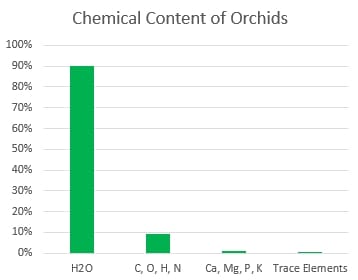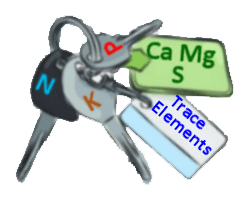If you seek the advice, you’ll find a myriad of recommendations about fertilizing our plants. Each of us has his or her opinion on the best brand, formula, and how much and how often. Likewise, when someone wants better growth, the first thing they do is feed their plants. But rarely does anyone ask just “how important is fertilizer?”.
We have all heard about someone’s grandma, who “never” feeds her plants, and we have also met folks firmly on the opposite end of the spectrum. Both, of course, have great plants that bloom profusely, so just how important can fertilizer be?
Let’s start by looking at the general makeup of an orchid:

Water is, by far, the biggest percentage of a plant, at about 90% of its total mass. The next largest fraction, at about 90% of the “dry weight”, consists of carbon (C), oxygen (O), hydrogen (H) and nitrogen (N). Our plants get the first three from the air and water, and it’s only the nitrogen that we provide.
The next fraction – calcium (Ca), magnesium (Mg), phosphorus (P) and potassium (K) – combine to make up less than 1% of the total mass of the plant. The final, “trace element” fraction, containing everything else, is only about 0.1% of the total. My Fertilizer Basics article tells you what each element does, so here we’ll look at them differently.
In order for any plant to gain one pound of mass, it must absorb and process about 200 pounds of water, but only about 5 grams of fertilizer nutrients. Nitrogen is, by far, the most important of those, and is the most important nutrient in any fertilizer. In nature, it comes from decomposing organic matter and nitrogen-fixing microbes. They are likely also what keeps “Grandma’s plants” going, but she had better be careful watering, or that decomposing potting medium will “take out” the roots.
Plants can readily redistribute most absorbed nutrients to new growth as they are needed. Calcium is an exception, however, so it must be provided continuously. Fortunately, most water supplies contain plenty of calcium and magnesium. If they aren’t present, as when using rainwater or RO, they must be provided by the grower.

If you want to paint a picture, imagine that your orchid plant is a fancy sports car. There are a whole lot of mechanical, electrical, and hydraulic systems involved with its operation, made up of all sorts of materials and processes to speed you down the road. Don’t forget though – without a key, it goes nowhere!

To plants, the various mineral ions act as the “keys” that allow the plant to live, grow, and bloom.
So far, all of this tells me that while fertilizer is necessary, it may not be all that important. There is, however, the “limiting factor” concept to consider. By that I mean, the plants may not need much to grow and bloom well, but anything in short supply will be a “damper”.
Because of that, I think it’s best to provide a good fertilizer formula in frequent, very small doses. That keeps the complete nutrient supply in the “good zone” for optimal growth and flowering.
One last thought: When it comes to feeding your plants, “more” is definitely not “better”! If you want to boost your growth and flowering, consider using Kelpak Premium Plant Growth Stimulant to kick things into high gear.